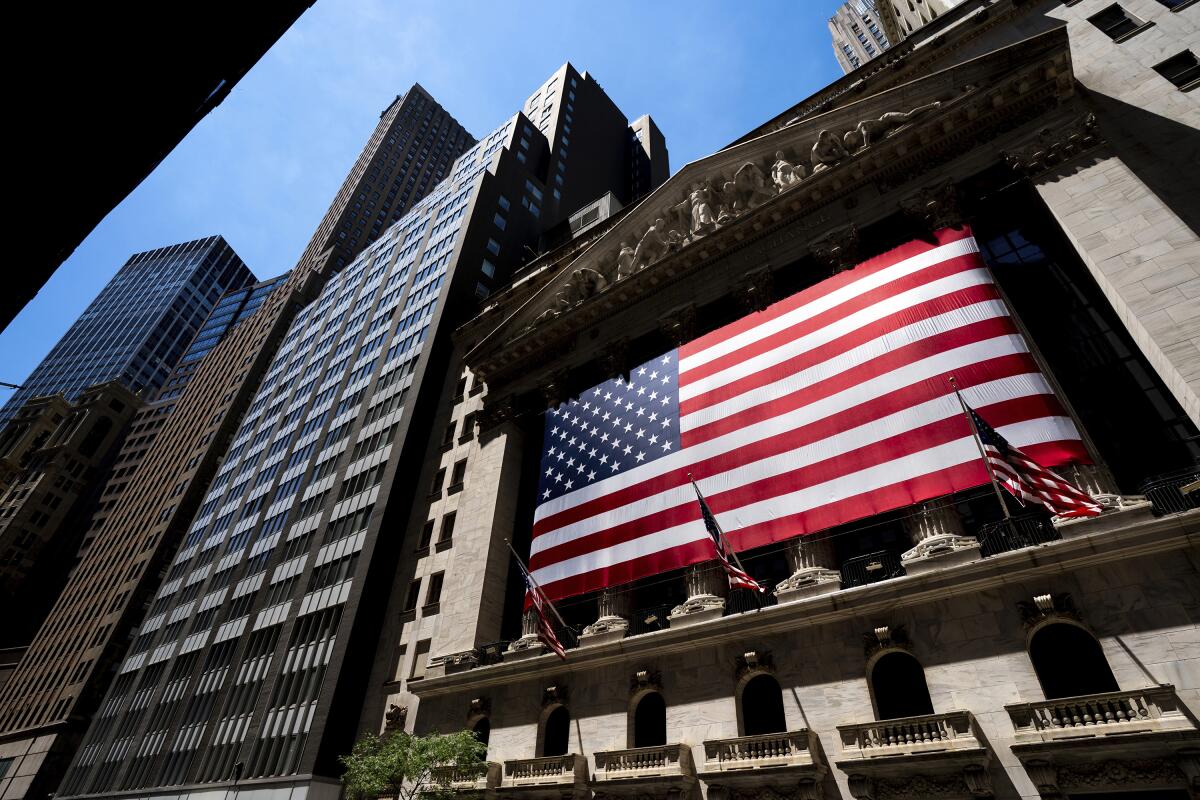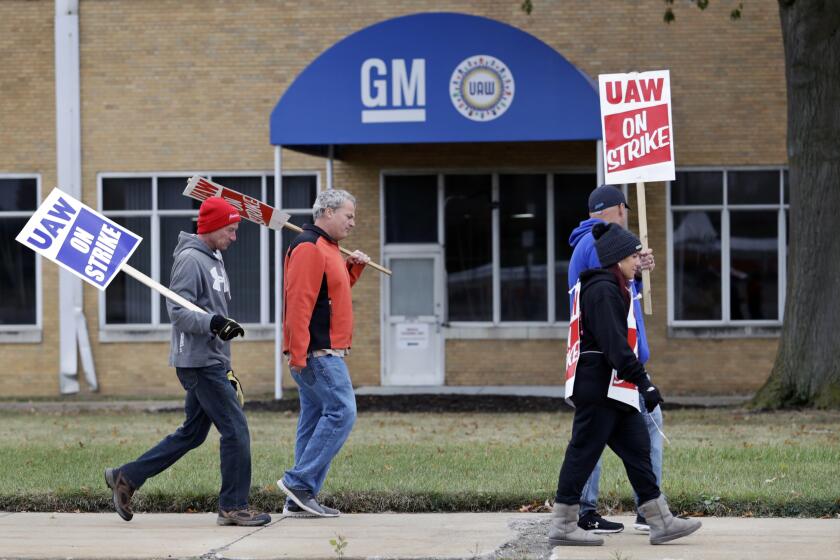Wall Street recovers some losses after falling 10% below its summertime high

- Share via
Wall Street clawed back some of its sharp recent losses Monday, ahead of a week that could send more big swings through financial markets.
Investors are looking forward to key reports on consumer confidence and the U.S. job market. The Federal Reserve announces its next move on interest rates Wednesday.
The Standard & Poor’s 500 rose 49.45 points, or 1.2%, to 4,166.82. It was the first trading after the benchmark index dropped more than 10% below its high point for the year.
The Dow Jones industrial average climbed 511.37 points, or 1.6%, to 32,928.96. The Nasdaq composite added 146.47 points, or 1.2%, to close at 12,789.48.
Western Digital helped prop up the market after it reported better results for the latest quarter than analysts expected. It also announced plans to split its company into two, one focusing on traditional hard disk drives and the other focusing on flash memory. Its stock jumped 7.3%.
McDonald’s reported stronger profit and revenue for the summer than analysts expected. Its stock rose 1.7% after it said it benefited from higher prices for its products in the United States and raised its dividend.
More than three-quarters of companies in the S&P 500 that have reported profit for the latest quarter have topped forecasts, according to FactSet. With roughly half the reports in, S&P 500 companies appear on track to deliver profit growth for the first time in a year.
“It looks like its coming in as the market had hoped, that we’re past the worst of it,” said Rob Haworth, senior investment strategist at U.S. Bank Wealth Management.
The results have also been good enough that earnings forecasts for the remainder of 2023 and 2024 seem to staying stable, he said.
Solid earnings are usually encouraging for the stock market, which tends to follow the trend of corporate profits over the long term. But Wall Street has been struggling recently because of a couple of big worries. First is the mixed reaction to profit reports from some influential Big Tech companies. Their stock movements carry extra weight on the S&P 500 because of their size.
General Motors reached a tentative agreement with the United Auto Workers to end a 6-week-old strike with similar terms to the deal signed by Ford.
Apple will report its latest quarterly results Thursday. Because it’s the most valuable stock on Wall Street, it is also the most influential stock on the S&P 500. Already, sharp drops for Alphabet and other Big Tech members after their profit reports have shaken the market this reporting season.
Big Tech soared much more than the rest of the market early this year, which helped to lift the S&P 500 but also meant big expectations for continued growth. Those expectations perhaps grew too large.
The second big factor dragging on the stock market since its high point for the year on July 31 has been a sharp run higher in Treasury yields. When bonds are paying higher yields, they make investors less willing to pay high prices for stocks and other investments. They also make borrowing more expensive for everyone, including huge corporations and home buyers, which puts the brakes on the economy.
The yield on the 10-year Treasury rose to 4.89% from 4.84% late Friday. It jumped from less than 3.50% during the spring to more than 5% earlier this month, its highest level since 2007. A remarkably resilient economy and other factors have the 10-year Treasury yield catching up to the main interest rate controlled by the Federal Reserve, which is above 5.25% and at its highest level since 2001.
The Fed has jacked up its federal funds rate in hopes of slowing the economy and stock prices enough to starve high inflation of its fuel. Its next meeting on interest rates will begin Tuesday, with an announcement coming Wednesday.
Jeep maker Stellantis has reached a tentative contract agreement with the United Auto Workers union that follows a template set by Ford, sources said.
The widespread expectation is that the Fed will leave the federal funds rate, which affects overnight lending by banks, alone. What will be more important is any hints the Fed gives about what it will do next. Fed officials have been saying they may keep rates high for a long time to ensure high inflation goes down, but they’ve also said the recent jump in longer-term Treasury yields could be acting like rate increases on their own.
The central bank says it will make all its upcoming moves based on what incoming data about the economy and inflation say. That’s why this week could be a shaky one for markets, with many data points that could change Fed officials’ minds.
On Tuesday, the government will release data on employment costs from July through September. Workers have been fighting for higher raises, but the Fed worries that too-high pay increases could give inflation more fuel.
On Wednesday will come the latest monthly update on the number of job openings across the country. One way the Fed could pull off the delicate balancing act of slowing the economy without creating a recession would be if the number of job openings cools without requiring waves of layoffs.
And then on Friday will come the jobs report for October, which is typically one of the most anticipated pieces of economic data every month.
Economists are preoccupied with making predictions about the future path of the U.S. economy, but keep getting fooled by the truth.
There will also be other updates on the economy and borrowing by the U.S. government, as well as profit reports from roughly 150 companies in the S&P 500, including CVS Health, Pfizer and Starbucks.
Several oil-and-gas producers will also be reporting, including Marathon Petroleum. They’ve benefited from a run in crude prices since the summer. A barrel of U.S. crude jumped from less than $70 to more than $93 earlier this month.
But oil prices have been shaky since the start of the latest Israel-Hamas war. Traders are still uncertain about whether the fighting will spill into the wider Middle East region and affect production from Iran or other big suppliers.
A barrel of U.S. crude fell 3.8% to $82.31 on Monday. Brent crude, the international standard, sank 3.3% to $87.45 a barrel.
In stock markets abroad, indexes rose in Europe.
AP writers Zimo Zhong and Matt Ott contributed to this report.
More to Read
Inside the business of entertainment
The Wide Shot brings you news, analysis and insights on everything from streaming wars to production — and what it all means for the future.
You may occasionally receive promotional content from the Los Angeles Times.













